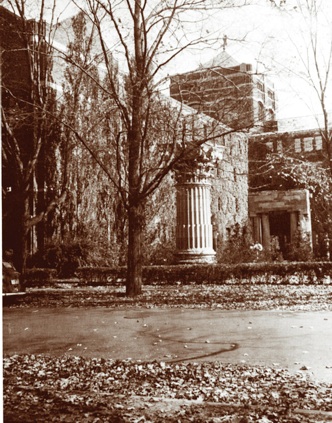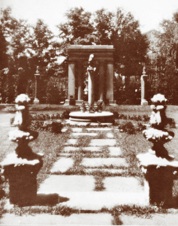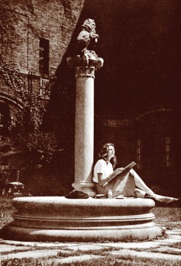A stranger, browsing through the by-ways of Ann Arbor and wandering down Monroe Street, will notice, back of the Architecture Building, an entranceway that apparently leads nowhere and a fine Corinthian column with nothing visible to support. Lest this occasion too much wonderment, let it be said at once that these are features of the garden of the College of Architecture and Design, and that they were put there for a definite and really practical purpose.
The garden was the idea of Emil Lorch, Professor Emeritus of Architecture and Director of the College until 1936. It was Professor Lorch's thought to establish an outdoor museum of architectural details worthy of study by architectural students and worthy of preservation for their artistic or historical importance. The time was favorable, for there was much building activity, and many older buildings, designed by prominent architects of the past and incorporating finely executed details, were being torn down and replaced by more modern structures. Professor Lorch's enthusiasm, abetted by the generosity of alumni and friends, brought together a small but nicely representative collection.
The door that leads nowhere (at present, at least), for example, is over 100 years old, and came from the original First National Bank Building in Detroit, at Jefferson and Griswold Streets — a good Greek revival piece. The Corinthian column came from an insurance company's building in Newark, N. J., and was presented by Colonel William A. Starrett, B.S.C.E. '97, D.Eng. (hon.) '31, who built the Empire State Building and a good many others. Then there is part of a Romanesque entrance from the old Post Office and Federal Building in Detroit and two large red stone reliefs designed by the distinguished architect, H. S. Richardson, whose influence on American architecture in the late nineteenth century was great. Present-day student architects study these pieces, and the members of drawing and painting classes often use them as models. And be-sides, it is a good thing for youthful creative artists to grow up amid objects of beauty, whole or fragmentary, indoors in glass cases or outdoors in a garden.
THE MICHIGAN ALUMNUS
October 14 1944, Page 32







